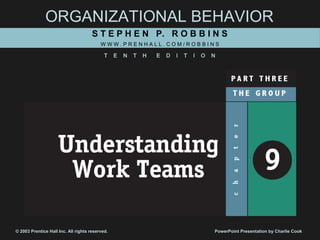
Ch09
- 1. ORGANIZATIONAL BEHAVIOR S T E P H E N P. R O B B I N S WWW.PRENHALL.COM/ROBBINS T E N T H E D I T I O N © 2003 Prentice Hall Inc. All rights reserved. PowerPoint Presentation by Charlie Cook
- 2. O B J E C T I V E S AFTER STUDYING THIS CHAPTER, YOU SHOULD BE ABLE TO: 1. Explain the popularity of teams in organizations. 2. Contrast teams with groups. L E A R N I N G 3. Identify four types of teams. 4. Describe conditions when teams are preferred over individuals. 5. Specify the characteristics of effective teams. 6. Explain how organizations can create team players. © 2003 Prentice Hall Inc. All rights reserved. 9–2
- 3. O B J E C T I V E S (cont’d) AFTER STUDYING THIS CHAPTER, YOU SHOULD BE ABLE TO: 7. Describe the advantages and disadvantages of diversity for work teams. 8. Explain how management can keep teams from becoming stagnant and rigid. L E A R N I N G © 2003 Prentice Hall Inc. All rights reserved. 9–3
- 4. Why Have Teams Become So Popular Why Have Teams Become So Popular Teams typically outperform individuals. Teams use employee talents better. Teams are more flexible and responsive to changes in the environment. Teams facilitate employee involvement. Teams are an effective way to democratize an organization and increase motivation. © 2003 Prentice Hall Inc. All rights reserved. 9–4
- 5. Team Versus Groups: What’s the Difference Team Versus Groups: What’s the Difference © 2003 Prentice Hall Inc. All rights reserved. 9–5
- 6. Comparing Work Groups and Work Teams Comparing Work Groups and Work Teams © 2003 Prentice Hall Inc. EXHIBIT 9-1 All rights reserved. 9–6
- 7. Types of Teams Types of Teams © 2003 Prentice Hall Inc. All rights reserved. 9–7
- 8. Types of Teams (cont’d) Types of Teams (cont’d) • Task forces • Committees © 2003 Prentice Hall Inc. All rights reserved. 9–8
- 9. Types of Teams (cont’d) Types of Teams (cont’d) Team Characteristics Team Characteristics 1. The absence of paraverbal and nonverbal cues 1. The absence of paraverbal and nonverbal cues 2. A limited social context 2. A limited social context 3. The ability to overcome time and space constraints 3. The ability to overcome time and space constraints © 2003 Prentice Hall Inc. All rights reserved. 9–9
- 10. Beware: Teams Aren’t Always the Answer Beware: Teams Aren’t Always the Answer Three tests to see if a team fits the situation: – Is the work complex and is there a need for different perspectives? – Does the work create a common purpose or set of goals for the group that is larger than the aggregate of the goals for individuals? – Are members of the group involved in interdependent tasks? © 2003 Prentice Hall Inc. All rights reserved. 9–10
- 11. Creating Effective Teams Creating Effective Teams © 2003 Prentice Hall Inc. All rights reserved. 9–11
- 12. Creating Effective Teams (cont’d) Creating Effective Teams (cont’d) © 2003 Prentice Hall Inc. All rights reserved. 9–12
- 13. Creating Effective Teams (cont’d) Creating Effective Teams (cont’d) © 2003 Prentice Hall Inc. All rights reserved. 9–13
- 14. Creating Effective Teams (cont’d) Creating Effective Teams (cont’d) © 2003 Prentice Hall Inc. All rights reserved. 9–14
- 15. A Team- A Team- Effectiveness Effectiveness Model Model © 2003 Prentice Hall Inc. EXHIBIT 9-3 All rights reserved. 9–15
- 16. Key Roles Key Roles of Teams of Teams © 2003 Prentice Hall Inc. EXHIBIT 9-4 All rights reserved. 9–16
- 17. Turning Individuals Into Team Players Turning Individuals Into Team Players The Challenges – Overcoming individual resistance to team membership. – Countering the influence of individualistic cultures. – Introducing teams in an organization that has historically valued individual achievement. Shaping Team Players – Selecting employees who can fulfill their team roles. – Training employees to become team players. – Reworking the reward system to encourage cooperative efforts while continuing to recognize individual contributions. © 2003 Prentice Hall Inc. All rights reserved. 9–17
- 18. Contemporary Issues in Managing Teams Contemporary Issues in Managing Teams Team Effectiveness and Quality Management Requires That Teams: 1. Are small enough to be efficient and effective. 2. Are properly trained in required skills. 3. Allocated enough time to work on problems. 4. Are given authority to resolve problems and take corrective action. 5. Have a designated “champion” to call on when needed. © 2003 Prentice Hall Inc. All rights reserved. 9–18
- 19. Team and Workforce Diversity: Team and Workforce Diversity: Advantages and Disadvantages of Diversity Advantages and Disadvantages of Diversity © 2003 Prentice Hall Inc. EXHIBIT 9-5 All rights reserved. 9–19
- 20. Reinvigorating Mature Teams Reinvigorating Mature Teams Problems of Mature Teams – Becoming stagnant and complacent as cohesiveness increases. – Developing groupthink. – Confronting more difficult issues. Reinvigorating Teams 1. Prepare members to deal with problems of maturity. 2. Offer refresher training. 3. Offer advanced training. 4. Encourage teams to treat their development as a constant learning experience. © 2003 Prentice Hall Inc. All rights reserved. 9–20
